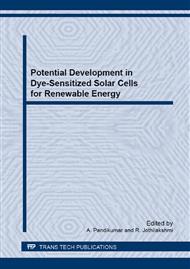[1]
A. Tricoli, A. S. Wallerand, M. Righettoni, Highly porous TiO2 films for dye sensitized solar cells, J. Mater. Chem. 22 (2012) 14254-14261.
DOI: 10.1039/c2jm15953h
Google Scholar
[2]
IEA, Key world Energy Statistics 2007, 25 (2007) 1-17.
Google Scholar
[3]
http:\www.mnre.gov.in/ mission-and-vision-2/achievements
Google Scholar
[4]
J. Preat, D. Jacquemin, E. A. Perpète, Towards new efficient dye-sensitized solar cells, Energy Environ. Sci. 3 (2010) 891-904.
DOI: 10.1039/c000474j
Google Scholar
[5]
B. O. Regan, M. Gratzel, Photoelectrochemical Solar cells, Nature. 353 (1991) 737-742.
Google Scholar
[6]
M. Grätzel, Solar Energy Conversion by Dye-Sensitized Photovoltaic Cells, Inorg. Chem. 44 (2005) 6841–6851.
DOI: 10.1021/ic0508371
Google Scholar
[7]
http:\www.solarserver.com
Google Scholar
[8]
http://www.commodityonline.com/news/dsc-photovoltaics-market-to-reach-$12-bn-in-2020- nanomarkets.html
Google Scholar
[9]
G. Liu, X. Yan, Z. Chen, X. Wang, L. Wang, G. Q. Lu, H. M. Cheng, Synthesis of rutile–anatase core–shell structured TiO2 for photocatalysis, J. Mater. Chem. 19 (2009) 6590-6596.
DOI: 10.1039/b902666e
Google Scholar
[10]
R. Shirley, M. Kraft, Electronic and optical properties of aluminium-doped anatase and rutile TiO2 from ab-initio calculations, Phys. Rev. B. 56 (2010) 075111-9.
Google Scholar
[11]
M. Gratzel, Mesoporous Oxide Junctions and Nanostructured Solar Cells, Curr. Opin. Colloid Interf. Sci. 4 (1999) 314-319.
Google Scholar
[12]
Y. Jun, J. Kim, M. G. Kang, A study of stainless steel-based dye-sensitized solar cells and modules, Sol. Energy Mater. and Sol. Cells. 91 (2007) 779-784.
DOI: 10.1016/j.solmat.2007.01.007
Google Scholar
[13]
K. Kalyanasundaram, M. Grätzel, Applications of functionalized transition metal complexes in photonic and optoelectronic devices, Coord. Chem. Rev. 177 (1998) 347-414.
DOI: 10.1016/s0010-8545(98)00189-1
Google Scholar
[14]
A. Tricoli, A. S. Wallerand, M. Righettoni, Highly porous TiO2 films for dye-sensitized solar cells, J. Mater. Chem. 22 (2012) 14254-14261.
DOI: 10.1039/c2jm15953h
Google Scholar
[15]
N. G. Park, Comparison of Dye-Sensitized Rutile- and Anatase-Based TiO2 Solar Cells, J. Phys. Chem. B. 104 (2000) 8989-94.
Google Scholar
[16]
G. Liu, X. Yan, Z. Chen, X. Wang, L. Wang, G. Q. Lu, H. M. Cheng, Synthesis of rutile–anatase core–shell structured TiO2 for photocatalysis, J. Mater. Chem. 19 (2009) 6590-6596.
DOI: 10.1039/b902666e
Google Scholar
[17]
D. Jyoti, D. Mohan, R. Dhar, Investigation of the opulent porosity for better performance of dye-sensitized solar cell, J. Renewable Sustainable Energy. 5 (2013) 013112-4.
DOI: 10.1063/1.4790811
Google Scholar
[18]
D. Jyoti, D. Mohan, R. Dhar, Purnima, Influence of electrode thickness on the performance of dye-sensitized solar cells, Invertis J. Renewable Energy. 1 (2011) 108-114.
Google Scholar
[19]
M. Grätzel, Perspectives for Dye-Sensitized Nanocrystalline Solar Cells, Prog. Photovolt. Res. ppl. 8 (2000) 171-185.
DOI: 10.1002/(sici)1099-159x(200001/02)8:1<171::aid-pip300>3.0.co;2-u
Google Scholar
[20]
M. Grätzel, Solar Energy Conversion by Dye-Sensitized Photovoltaic Cells, Inorg. Chem. 44 (2005) 6841–6851.
DOI: 10.1021/ic0508371
Google Scholar
[21]
A. Hagfeldt, M. Gratzel, Molecular Photovoltaics, Acc. Chem. Res. 33 (2000) 269-277.
Google Scholar
[22]
K. Kalyanasundaram, M. Grätzel, Applications of functionalized transition metal complexes in photonic and optoelectronic devices, Coord. Chem. Rev. 177 (1998) 347-414.
DOI: 10.1016/s0010-8545(98)00189-1
Google Scholar
[23]
A. Hagfeldt, Verification of high efficiencies for the Grätzel-cell. A 7% efficient solar cell based on dye-sensitized colloidal TiO2 films, Sol. Ene. Mater. & Sol. Cells, 31 (1994) 481-488.
DOI: 10.1016/0927-0248(94)90190-2
Google Scholar
[24]
Solaronix, Dye Solar Cell Assembly, instructions received from Solaronix SA, (2000).
Google Scholar
[25]
H. Zabri, F. Odobel, S. Altobello, S. Caramori, C. A. Bignozzi, Efficient osmium sensitizers containing 2,2'-bipyridine-4,4'-bisphosphonic acid ligand, J. Photochem. Phtobio. A: Chem. 166 (2004) 99-106.
DOI: 10.1016/j.jphotochem.2004.04.030
Google Scholar
[26]
N. Onozawa-Komatsuzaki, M. Yanagida, T. Funaki, K. Kasuga, K. Sayama, H. Sugihara, Near IR dye-sensitized solar cells using a new type of ruthenium complexes having 2,6-bis (quinolin-2-yl) pyridine derivatives, Sol. Energy. Mater. Sol. Cells. 95 (2011) 310-314.
DOI: 10.1016/j.solmat.2010.05.003
Google Scholar
[27]
R. C. White, J. E. Benedetti, Agnaldo D. Gonc¸ Alves, W. Romão, B. G. Vaz, M. N. Eberlin, Carlos R.D. Correia, Marco A. De Paoli, A. F. Nogueira, Synthesis, characterization and introduction of a new ion-coordinating ruthenium sensitizer dye in quasi-solid state TiO2 solar cells, J. Photochem. Photobio. A: Chem. 222 (2011) 185-191.
DOI: 10.1016/j.jphotochem.2011.05.020
Google Scholar
[28]
G. Wolfbauer, A channel flow cell system specifically designed to test the efficiency of redox shuttles in dye sensitized solar cells, Solar Energy Materials & Solar Cells. 70 (2001) 85-101.
DOI: 10.1016/s0927-0248(00)00413-x
Google Scholar
[29]
L. L. Kazmerski, Photovoltaics: A review of cell and module technologies, Renew. Sustain. Energy Rev. 1 (1997) 71-170.
Google Scholar
[30]
N. Papageorgiou, An Iodine/Triiodide reduction Electrocatalyst for Aqueous and Organic Media, J. Electrochem. Soc. 144 (1997) 876-84.
DOI: 10.1149/1.1837502
Google Scholar
[31]
A. Kay, M. Grätzel, Low cost photovoltaic modules based on dye sensitized nanocrystalline titanium dioxide and carbon powder, Sol. Energy Mater. Sol. Cells. 44 (1996) 99-117.
DOI: 10.1016/0927-0248(96)00063-3
Google Scholar
[32]
Y. Chiba, A. Islam, Y. Watanabe, R. Komiya, N. Koide, L. Han, Dye- sensitized solar cells with conversion efficiency of 11.1%, Jpn. J. Appl. Phys. 45 (2006) L638-L640.
DOI: 10.1143/jjap.45.l638
Google Scholar
[33]
B. Li, L. Wang, B. Kang, P. Wang, Y. Qiu, Review of recent progress in solid state dye sensitized solar cells, Sol. Energy Mater Sol. Cell. 90 (2005) 549-573.
DOI: 10.1016/j.solmat.2005.04.039
Google Scholar



